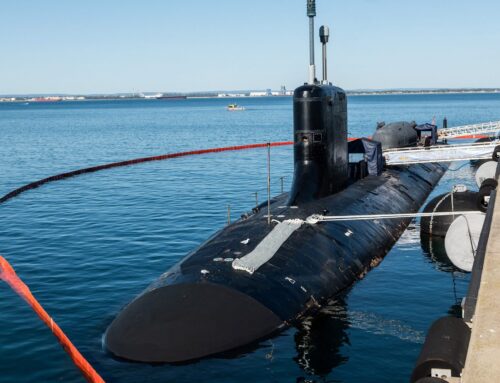A SpaceX Falcon 9 rocket carries two comsats belonging to a Norwegian firm as it launches from Vandenberg, California on Aug, 11, 2024. (SpaceX Livestream via X)
WASHINGTON — Norway’s two dual-use satellites for communications over the Arctic region successfully lifted off on Sunday night carrying a US military hosted payload — marking the first time an operational US military payload has been hosted on a commercial satellite operated by an allied partner and setting up a model for future international cooperation, according to US government and industry officials.
The Arctic Satellite Broadband Mission (ASBM) constellation, built by Northrop Grumman for Space Norway, lofted on a SpaceX Falcon 9 from Vandenberge SFB, Calif., into a highly elliptical orbit that passes over the poles and thus provides coverage of the northern latitudes including Russia.
Space Norway is a government-run holding company for space operations based in Oslo.
“There is a critical need for polar satellite communications, and that need has grown exponentially in the last few decades. The partnership with Space Norway for this mission is the first step at securing the Arctic region and paving the way for future international partnerships here at SSC [Space Systems Command] and across the Space Force,” Maj. Michael Walsh, chief of the SSC EPS-R branch, said in a June 27 press release [PDF] when the two EPS-R payloads arrived at the Vandenberg launch site.
Communications is one of the keystones of the Pentagon’s latest Arctic Strategy, which is strongly based on cooperation with NATO allies in the region.
The two birds “work together as a team to make sure we constantly have that coverage of what otherwise like in the world of comm satellites is kind of a tricky place to reach,” Blake Bullock, vice president for communications systems at Northrop Grumman’s Strategic Space Systems division, told Breaking Defense in an interview prior to the launch.
The satellites carry a handful of different payloads, including the two US Space Force Enhanced Polar System-Recapitalization (EPS-R) jam-resistant communication payloads, an X-band (microwave) communications payload for Norway’s Ministry of Defence, and a Ka-band payload for commercial firm Viasat (which also provides the Space Force with comsat services).
The EPS-R payloads also operate in the EHF band (which ranges between 30 and 300 GHz), using the Advanced EHF’s eXtended Data Rate (XDR) waveform to provide high-speed data rates. They are replacing the ancient Enhanced Polar System extremely high frequency (EHF) payloads that were “acquired from a classified host” in 2007 and accepted for operational use by US Space Command in November 2019, according to a 2019 [PDF] Defense Department Selected Acquisition Report.
The EPS-R constellation, originally expected to launch in 2022, will provide interim Arctic communications for US military operators, in particular Northern Command that for years has been begging for improved communications capabilities, until the Space Force’s two major milsatcom programs are up and running. These are the Protected Tactical SATCOM (PATS) family of systems and the Evolved Strategic SATCOM — both of which are being designed to replace the current Advanced Extremely High Frequency (AEHF) satellites, which provide highly encrypted communications for both strategic and tactical needs including over the polar region.
The EPS-R payload was “built on the shoulder of decades of work that Northrop did as the mission payload prime for the Advanced EHF satellites,” Bullock noted.
She explained that the overall system design of the ASBM satellites allows US military communications to be walled off from the rest of the on-board operations for security reasons.
“At the end of the day, basically, what we’re able to do is isolate the Space Forces payload from the rest of the platform … so that they’re not all sharing information and they’re not all connected. So you get all the benefits of having that platform and that ride and that power source and everything else, but all of the critical sensitive information is completely isolated from the rest of the satellite,” Bullock said.
Thus, the Space Force “can kind of speak to and command the EPS-R as if it were its own satellite,” she added.
Northrop Grumman is also supplying the ground system for the EPS-R satellites, called the Control and Planning Segment, or CAPS, that “receives telemetry and supplies configuration commands, mission planning and cryptographic planning for the EPS and EPS-R polar-orbiting payloads,” according to a company fact sheet.











